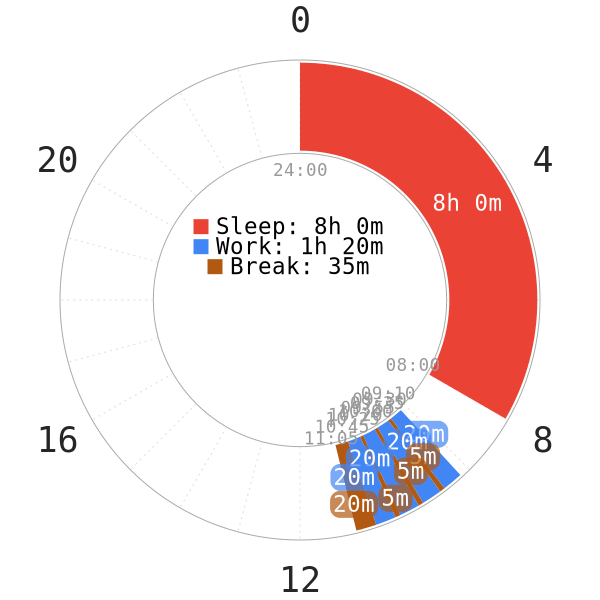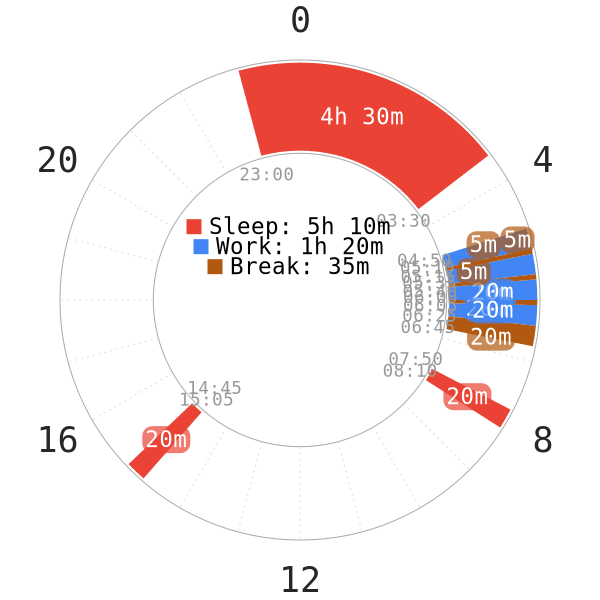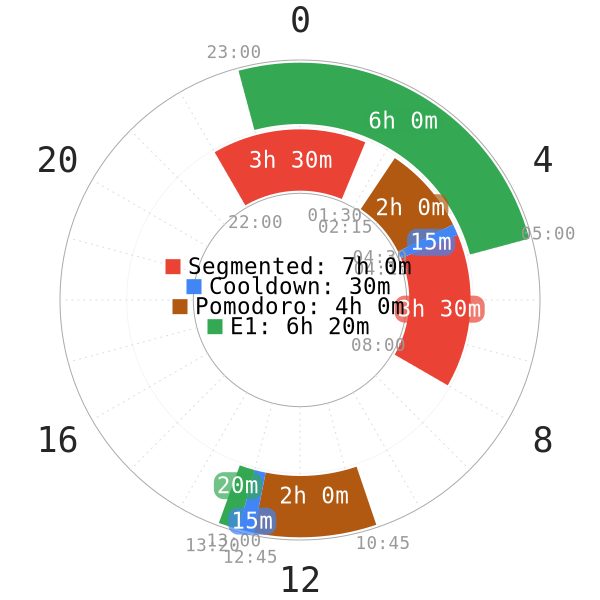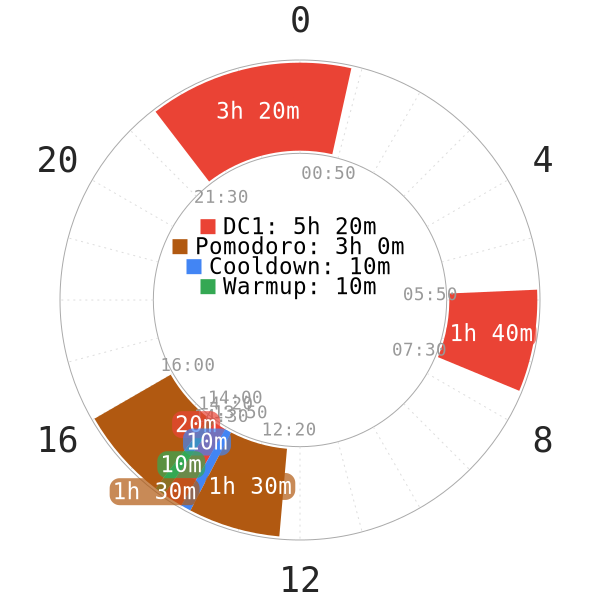Introduction
The traditional Pomodoro Technique consists of a cyclic period of doing an activity for 25 minutes followed by a 5-minute break; this constitutes several chunks of 30 minutes1.
- After 4 Pomodoros, the break becomes longer, anywhere from 15 to 30 minutes.
- Alternative Pomodoro variants include a longer period of activity followed by a slightly longer break. For example, 45 minutes of studying/working and a 10-minute break.
- The premise of this time-control technique is to train humans to focus on one task at hand. It has proved to be effective against procrastination.
- Taking a short break can refresh the mind and carry a consistently high level of productivity into later daytime hours.

This blog post will detail more potential cautions with Pomodoro as well as how polyphasic sleeping is related to this technique. There will be certain ways polyphasic sleepers can make use of Pomodoro to each their own.
Content
- Polyphasic Sleep Principles and Pomodoro Technique
- Sleep Deprivation Effects
- Applications in Polyphasic Sleep
- Today’s Usage and Downsides
Pomodoro in Conjunction with Polyphasic Sleeping
In a sense, the cyclic division between activities and break in the Pomodoro Technique appears to be similar to polyphasic sleeping. The cyclic division of sleep and wake hours during the day is what constitutes polyphasic sleeping.
Waking hours represent time spent on activities, while sleeping hours represent break time from said activities.

Using Pomodoro on polyphasic scheduling
Of 24 hours each day, sleep takes up a portion as means to replenish the body with rest.
- The remaining waking hours split into several smaller segments of activities by choice.
- During night time where one spends the peaceful waking hours in the dark period with dimmer lighting, the standard Pomodoro variant (25-5-25-5) can be useful. This helps form the habits of focusing on one specific task during each 25-minute block and set different goals for each block.
During the 5-minute break period, the following options are viable:
- Stretching
- Drinking some water for hydration
- Splashing some water onto your face to relieve the potential stress on your eyes. This can greatly help sustain ocular performance with increased wake time on a polyphasic schedule.
Five minutes do not last, so avoid time-consuming activities or those that work up your mind1. A longer work-break Pomodoro variant can work out as well if consistent enough. In addition, it also works if you have already been familiar with your own Pomodoro duration.
Other advice
A Pomodoro beginner should start out with the standard version.
- 25 minutes may appear short, but there is potentially a lot of distraction getting in the way. These include social media notifications, personal message inboxes and other forms of procrastination.
- Human’s attention span is decreasing over the year, from 12 seconds in 2000 to only 8.25 seconds in 20152. Therefore, it is better to start with a shorter activity period and a shorter break period as well.
- Longer break periods can invite more procrastination and waste of productive time.
Currently, only some polyphasic sleepers in the community who have actually practiced the Pomodoro technique with positive results. Most of these Pomodoro variants, however, usually involve a longer work period and a slightly longer break period.
These alternate variants also appear to be more realistic to maintain on a consistent basis than the traditional version. Especially in work settings that demand constant productivity, it becomes difficult to pull off the Pomodoro technique consistently.
Sleep Deprivation and Sleep Quantum Value
How sleep deprivation can affect productivity
Depending on sleep deprivation intensity and polyphasic pattern, it can be impossible to achieve the desired productivity level with extra waking hours. This is at least during the adaptation phase.
- Sleep deprivation can affect productivity on a very big scale; there is a loss of roughly 1 hour and 54 minutes of productivity time among Korean workers weekly3.
- To not completely butcher productivity during adaptation, pick a reasonable polyphasic schedule. This would help avoid spending most or all of the waking hours fighting sleep deprivation. You lose a lot of extra time putting all efforts into only staying awake.
- The number 1 hour and 54 minutes above only applies to the sleep deprived state and may not apply to successful polyphasic adaptations.
Minimum sleep to sustain long-term performance
Claudio Stampi suggested that the sleep quantum value refers to the minimum amount of sleep duration each day to sustain productivity and performance for an extended period of time.
- A six-week Uberman adaptation might look tempting with a lot of extra waking hours; however, long-term performance may severely suffer. There is also a very brutal adaptation period.
- Normal human beings with no special genetic mutations often require anywhere from 7-9 hours of monophasic sleep daily to be fully rested.
- In terms of sleep reduction and long-term performance, 4.5-5.5 hours of uninterrupted sleep, or at the very least, 4 hours sleep as a total of all sleep blocks on the schedule daily is necessary to sustain performance for an extended period of time4.
Thus, it is important to note that sleeping less does not always equate more productivity; certain polyphasic schedules should account for the minimum baseline of sleep. In addition, other environmental factors (e.g, stressful work, difficult professions) can affect sleep quality. This in return can affect productivity time while awake to varying extents.
With all combined factors, It is a common misconception that anyone can adapt to highly extreme polyphasic schedules while gaining superhuman productivity. The Pomodoro technique can cope with sleep deprivation symptoms to keep you awake during the most intensely sleep-inducing hours (e.g, dawn, graveyard hours); however, intensified sleep deprivation will most likely affect the effectiveness of Pomodoro as productivity declines.
Pomodoro’s Specific Applications in Polyphasic Schedules
Since there is a great variety of polyphasic schedules, the Pomodoro technique will vary with some margins between these schedules. This section will discuss how and when to use the Pomodoro technique under different polyphasic schedules.
NOTE:
The representation of the Pomodoro technique in the napcharts below is one possible way to implement the Pomodoro technique. There are viable alternatives depending on personally preferred physically/mentally active hours. These hours are likely to vary from person to person.

Recall from the previous section that waking hours in a polyphasic schedule represent time spent on activities, while sleeping hours represent break time from said activities. Using this strategy, a short nap of 20 minutes or less on a polyphasic schedule can be a 4th “break” period. In fact, the idea of inserting a nap during a Pomodoro break as a form of polyphasic sleeping was already suggested5.
- The first 3 Pomodoro activity-break cycles of a 25-minute focus on a specific activity.
- 5-minute breaks are the same as in the traditional Pomodoro variant; however, the last Pomodoro cycle start with a 25-minute work followed by a short cooldown of 5-15 minutes.
- The nap can be 20 minutes long or shorter.
- This cooldown duration also depends on how mentally/physically taxing the Pomodoro period is.
- For mentally demanding activities, the cooldown period should be a bit longer and vice versa. Experienced and long-term adapted polyphasic sleepers need a very short cooldown (much less than 5 minutes) to prepare for their sleeps.
- The cooldown period with no important activities (other than some stretching and moving around) is necessary to help the brain enter a slow-wave state to facilitate sleeping.
- The same strategy is applicable to other 20-minute naps on other polyphasic schedules (e.g, Everyman and Dual Core) as well.
Pomodoro on Dual Core 1

First 4 cycles of Pomodoro’s Activity-Break
The first 4 cycles of the Pomodoro technique can begin with planning the activities below. This takes advantage of the afternoon nap in the middle of 2 Pomodoro blocks.
Work block 1: 11:50-12:15 (25 minutes)
Task: Programming/Problem Solving
Break 1:12:15-12:20 (5 minutes)
NOTE:
There is a suggestion that sleeping for the whole 5 minutes during the break to “shut down” brain activity briefly is a good relaxation method5. However, while adapting to a polyphasic schedule, this is a bad idea! A 5-minute rest can result in a big oversleep if sleep deprivation level is high enough. Five minutes also are usually too short to contain vital sleep stages4 (except under severe sleep deprivation conditions).
This relaxation method was also comparable with polyphasic sleeping, where napping effectively counts as actual sleep. It may even help with sleep reduction5; however, if this brief nap is outside the scheduled sleep blocks, it can hinder adaptation progress.
The only sleep patterns that can make use of this napping condition are flexible, random, non-reducing types or after the adaptation phase. For example, sleepers take naps whenever they feel tired enough on SEVAMAYL. Therefore, sleeping during this brief period is NOT recommendable with a strict, rigid polyphasic schedule in adaptation.
Work block 2: 12:20-12:45 (25 minutes)
Task: Programming/Problem Solving/More brainstorming
Break 2: 12:50-12:55 (5 minutes)
NOTE: Mentally or physically demanding tasks (e.g, programming) like above can continue the flow from the first work block after break 1. This prevents any disruptions from interfering with information processing. For an activity that requires an extended amount of time to finish, it is important to maintain the workflow.
Work block 3: 13:00-13:25 (25 minutes)
Task: Memorizing biology notecards
Break 3: 13:25-13:30 (5 minutes)
Work block 4: 13:30-13:55 (25 minutes)
Task: Memorizing bigger biology notecards
Break 4: 14:00-14:10 (10 minutes).
During this break, useful, brief activities (e.g, stretching, moving food from freezer to fridge to defrost, place a small reminder of what to do after awakening on the desk, focus on regular breathing) are viable.
NAP (Sleep Break): 14:10-14:30 (20 minutes)
NOTE: The nap goes here because of the longer Pomodoro break (after 4 activity-break cycles). A break duration of at least 15 minutes is long enough to justify placing a nap for some restorative effects. This is a good nap placement on a polyphasic schedule to make use of both the Pomodoro activity-break and the nap in between.
Second 4 cycles of Pomodoro’s Activity-Break
Work block 5: 14:35-15:00 (25 minutes)
Task: Some exercise to wake the body up (e.g, jumping jacks, chores)
Break 5: 15:00-15:05 (5 minutes)
Work block 6-8:
Task: Recalling learned biology notecards/Problem solving
General applications to other polyphasic schedules
The above example is the order of how napping can ride along with the Pomodoro.
- Regarding the cooldown period before sleep, a brief period of warmup is a fine idea upon awakening.
- Adapted sleepers will usually have a very short warm-up period compared to those who are adapting.
The reason is that some sleep inertia is always present upon awakening, regardless of sleep deprivation levels.
- The first work block after a sleep break can go with certain physical activities (e.g, jumping jacks) to wake the body up. This has been effective in combating sleep deprivation during the adaptation period. Warmer body temperature also sets up the motivation to muster productivity to maintain the next Pomodoro goals.
- After this period, the Pomodoro technique can resume like before. A brief activity period of 25 minutes followed by a 5-minute break.
- Right upon awakening, tasks that are less important should be chosen (e.g, warm-up physical activities, small chores) until you are fully awake. This process may take more than 1 Pomodoro cycle of activity-break depending on sleep deprivation levels.
- Regarding learners and students, useful activities after waking up from a nap/core sleep include the following: recite previously learned materials from before the sleep block. This is a good way to make use of napping benefits to aid with learning.
Chronotypes
Another strategy to make use of the Pomodoro technique is to use personally preferred mentally active hours to cope with demanding activities that require stronger focus. This choice comes down to chronotypes.
- Lions, who prefer to start the day early, can start a more intense Pomodoro at these specific hours.
- On the other hand, Wolves, who prefer the evening hours, can dedicate those hours to finish these work chunks.
- During hours that result in a less active mindset, complete less intense and focus-required tasks instead.
Core-only schedules
On a schedule with only core sleeps like Segmented, the Pomodoro technique can behave in a similar fashion.
- After 1 or a couple full Pomodoro cycles of activity-break, polyphasic sleepers can have a longer nap or a core to refresh the mind.
- Regardless of schedules, having a brief cooldown before each sleep helps lower sleep onset latency. Thus, by using sleep times as part of the Pomodoro technique, polyphasic sleepers can utilize the waking and sleeping hours better by dedicating time to not only working but also proper resting when the brain gets tired.
Viability of Pomodoro Today and Potential Downsides
Those with anxiety may find Pomodoro very difficult, because of the pressure from the ticking clock1.It is important to take this into consideration before attempting Pomodoro. Despite the overwhelming evidence that it is impossible to make Pomodoro work in a constrained working environment, Pomodoro is still applicable at home or even in schools and universities.
Schools often offer a brief break period after each course (~1-2h long depending on locations). It also takes about 10-15 minutes to walk from class to class. This is by far the most realistic use of a work-break method similar to Pomodoro, even though technically it is not the exact same thing. During night hours, it is very ideal to practice Pomodoro to stay motivated during adaptation, rather than having nothing to do and feeling sleepy all the time.
Conclusion
The Pomodoro technique is a very useful tool to boost motivation during difficult adaptation stages. In addition, it can help train personal discipline in keeping track of activities and how to manage time better. However, Pomodoro also has its own flaws and may not fit certain personality or conditions (e.g, constant distraction, sleep deprivation).
Although it is hard to consistently maintain Pomodoro on a daily basis nowadays, it remains a good utility to fight off procrastination and motivates task completion. This aids in outlining and planning to achieve personal goals. As a result, it is important to carefully consider a suitable polyphasic lifestyle with a clear set of objectives to maintain productivity for as long as possible.
Pomodoro technique promises to deliver good results, but only if you have the necessary skills to make it work. Make time and the waking hours count for you, not against you!
Main author: GeneralNguyen
Page last updated: 9 April 2021
Reference
- Cirillo, Francesco. The Pomodoro Technique : The Acclaimed Time Management System That Has Transformed How We Work. New York, Currency, 2018.
- Web Desk. “The Human Attention Span [INFOGRAPHIC].” Digitalinformationworld.Com, 10 Sept. 2018, www.digitalinformationworld.com/2018/09/the-human-attention-span-infographic.html. Accessed Feb. 22. 2020.
- Woo, Jong Min, et al. “Productivity Time Lost by Sleep Disturbance among Workers in Korea.” Journal of Korean Neuropsychiatric Association, vol. 50, no. 1, 2011, pp. 62–68, www.komci.org/GSResult.php?RID=0055JKNA%2F2011.50.1.62&DT=6. Accessed 23 Feb. 2020.
- Stampi, Claudio. Why We Nap : Evolution, Chronobiology, and Functions of Polyphasic and Ultrashort Sleep. Birkhauser, 2014.
- Staffan Noteberg. Pomodoro Technique Illustrated : The Easy Way to Do More in Less Time. Pragmatic Bookshelf, 2013.


One thought on “Polyphasic Sleeping: A Macroscopic Vision of the Pomodoro Technique”